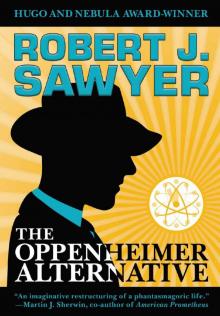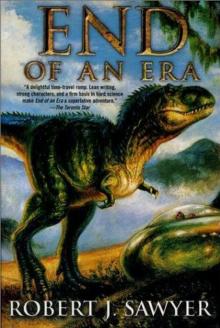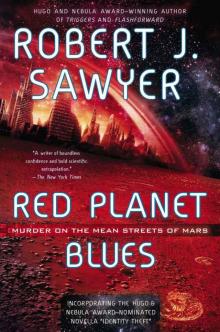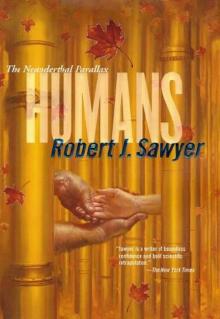- Home
- Robert J. Sawyer
End of an Era Page 3
End of an Era Read online
Page 3
Klicks grunted assent, and we each took hold of one of the red wheels that worked the louvers around the upper edge of the curving outer wall. My ears popped as pressure equalized. Cloying pollens wafted in and I was grateful I’d taken a Seldane before the Throwback.
The night was alive with weird insect sounds: zippings and chirpings and tick-tick-tickings and low, throbbing hums. There was wire mesh over the vents to keep the insects out, but I cringed at the thought of having to face the clouds of prehistoric bugs tomorrow.
"The moon’s coming up," said Klicks. I turned and looked out the window. Fat and amber, waxing, about three-quarters full, the moon’s pitted face reflected in the still waters of the lake to our south.
"Christ, look at that," exclaimed Klicks. It took me a moment to figure out exactly what was wrong with the moon’s face. It had turned so that a good part of what was the backside in modern times was clearly visible. I could see some of what must have been Mare Moscoviense on the eastern limb. Librations do let us see a bit of the backside in the twenty-first century, but Moscoviense started at around 140 degrees east latitude, way around back. My first thought was that the moon must not yet be tidally locked, but I rejected that; its orbit was too close for it to be anything but. No, more likely this was the one side that faced Mesozoic Earth. I wondered what had caused Luna to twist in its orbit between now and my time.
"It looks small," said Klicks.
I thought about that. The moon did indeed seem smaller than normal. That was funny, since we’d assumed it would actually be closer to the Earth now, orbiting objects having a tendency to spiral away slowly over millennia. Still, the moon’s apparent size normally changes by about thirty percent as it moves from perigee to apogee, but most people never notice that; the human eye is notoriously inaccurate at gauging such things. Still, the moon did look small.
Through the binoculars I could see other evidence that this was indeed a younger Luna. I looked at where Giordano Bruno should have been. Normally, that crater is right on the limb of the full moon, but here it should have been well in from the edge of the disk. As I suspected, its series of 500-kilometer-long rays was nowhere to be found. Five British monks in a.d. 1178, their faces tipped toward the heavens, had actually seen the meteor impact that had made that crater.
I thought about mentioning the missing crater to Klicks, but talk of meteor strikes always sparked the debate between us about whether one such had caused the Cretaceous-Tertiary extinctions. Klicks bought that theory. In the eyes of the general public, that made him right in line with mainstream thinking. After all, the newspapers and PBS shows in the 1980s had all concluded that an asteroid impact was indeed the culprit. I wasn’t in the mood to rehash it all again — I’m more inclined to lock horns with Klicks after a few brews, and, sadly, there were none among our provisions — but then something happened that brought up the old debate anyway. Slowly, quietly, without any fuss, a second moon was rising after the first. It was smaller, only about a third the apparent diameter of Luna. Spherical, it too was waxing gibbous, looking like a white jelly bean.
"Klicks?" I said.
"I see it."
I brought my binoculars to bear on the tiny orb, but its face was too small to show any detail. "Trick," I said, surprising myself. "I think we should call it Trick."
"After Charles Trick Currelly, no doubt," said Klicks, wanting to demonstrate that he got the reference. C. T. Currelly, an early-twentieth-century archaeologist, was the founder of the Royal Ontario Museum, where I worked. One of my occasional forays into the world of popular writing had been a biography of him for Rotunda, the ROM’s member magazine. Klicks did not dispute my choice of name and I was grateful for that small miracle.
We watched the two moons for some time. It seemed that Trick was catching up with Luna, meaning that it was in a much lower orbit. Since Luna is tidally locked, so that the same side always faces Earth, that would mean that Trick probably was also. It must be under a lot of gravitational stress being that much closer…
Aha!
"There goes the periodic extinction theory," I said, excitement in my voice.
The Alvarez Group at Berkeley published their asteroid-impact extinction theory in Science in 1980. About the same time, an interesting hypothesis was making the rounds concerning the Eocene-Oligocene extinctions, the ones that would come 30 million years after the demise of the dinosaurs. According to it, those later extinctions resulted from a general cooling caused by the breakup of an ancient second moon, leaving Earth with a temporary equatorial ring of orbiting debris that blocked enough sunlight to lower temperatures for a million years or so. The Alvarez theory, sexy because it dealt with dinosaurs and embraced by many pop-science communicators after Sagan had linked it to nuclear winter, eclipsed the ringed-Earth discussions.
Others, including Klicks, tried to push the Alvarez theory a step further, claiming that bolide impacts at regular intervals, caused perhaps by a dark star periodically disturbing either the asteroid belt or the Oort cloud, were responsible for a regular schedule of extinctions, including both the K-T and the E-O. That idea never washed with me, since to get the 26-million-year periodicity you had to use the late Ordovician dyings, which were obviously just the result of plate tectonics moving the supercontinent Gondwanaland over the south pole, causing an ice age.
Klicks knew my position on all of that, of course, so I simply pointed at the second moon. "Trick provides a one-of-a-kind explanation for the Eocene-Oligocene extinctions," I said. "There’s nothing periodic about a moon breaking up."
To his credit, Klicks didn’t contest that. But he did say, "Why link it to those deaths? Why not to the ones that are about to occur?"
"Tektites," I said, referring to the glassy, moon-like rocks found at various locations on Earth. "The age of the southeastern U.S. tektite field coincides with the E-O boundary. I bet they were caused by the impacts of the remnants of Trick."
Klicks was quiet for a minute or so, although I could hear him grinding his teeth in the dark, the way he does when he’s thinking — chewing over a problem, you might say. Finally he spoke. "We have sleeping pills."
"Huh?" I guess the change of subject meant I had won that round, but I couldn’t see what he was getting at.
"I said, we could take something to get to sleep. We’re going to be useless in the morning if we stay awake all night."
I never took sleeping pills. I knew I had an addictive personality — another one of Dr. Schroeder’s little insights. That meant messing with any drug would be out of the question for me. Hell, I have a hard enough time avoiding pizza, and Schroeder swears that there’s nothing in the old double-cheese-and-pepperoni that could cause a chemical dependency. Still, what Klicks said made sense. I could hear him moving around the dark cabin. When he opened our medicine refrigerator a small yellow bulb came on, illuminating its interior. Klicks found the bottle he was looking for and, leaving the door open so that he’d have some light, went to the sink and filled a couple of paper cups. We had more than enough water in the tank beneath our feet to last the eighty-seven hours we would be here, that being the maximum length of time the Huang Effect could hold a lock on us when casting this far back.
"Here," he said, offering me one of the Dixie cups and a silver caplet. I slipped the pill into my breast pocket. Klicks kicked the fridge door shut and all was darkness for a moment, until he turned the overheads back on, their brightness making us both squint. He turned the crank on the side of his crash couch, and it ratcheted around from its normal sitting configuration into a flatbed position.
I moved away from the window, from the odd spectacle of Trick slowly chasing Luna through the forest of stars, and converted my couch to sleeping mode, too.
Next, I changed into my pajamas. While doing so, my eyes kept being drawn out the window to the sight of the two
moons. Even if the existence of Trick disproved the periodic extinctions theory, I was sure Klicks would stick to the asteroid model
for the death of the dinosaurs.
It’s frustrating being a paleontologist. My neighbor Fred — the one with the dead cat — once said to me, hey, now that they know what killed the dinosaurs, guess your job is pretty much over. That seems to be the public’s attitude. But, really, it’s all because a couple of astronomers and physicists who knew nothing about dinosaurs and a couple of glib talkers from the paleontological community who wanted some limelight pushed the idea so vigorously that it got, quite literally, more popular-press coverage than any scientific theory since World War II.
But it’s just a theory, and not a very good one at that. Yes, there’s no longer much doubt that there was an impact of a ten-kilometer-wide asteroid at or near the end of the Mesozoic. But the Mesozoic lasted 160 million years, and during it there were at least seven other large-asteroid impacts. Each is at least as well documented as the supposed dinosaur-killer (one formed the 100-kilometer-wide Manicouagan crater in Quebec), and there’s zero turmoil in the fossil record associated with any of them.
It’s what Bob Bakker calls the frog problem: frogs, notoriously sensitive to climactic change, survived the end of the age of dinosaurs just fine, but big animals, which should have had more resistance, were all killed off. An asteroid impact is the wrong sort of scenario to explain the selective extinctions we see in the fossil record.
Sure, there’s a buried crater called Chicxulub half on land and half beneath the sea near the northern coast of Yucatan, Mexico. And, yes, by the early 1990s, a series of tests had dated it to very close to the K-T boundary. But with so many confirmed and possible Mesozoic craters, it surprised me that the impact-extinction theory continued to have any legs. Beside Chicxulub and Manicouagan, the later dated at 214 million years before the time I’d been in when I’d woke up this morning, there’s also the 175-million-year-old Puchezh-Katunki crater in Russia, the 145-million-year-old Morokweng crater in South Africa, the 144-million-year-old Mjolnir in the Barents Sea, the 128-million-year-old Tookoonooka in Australia, the 117-million-year-old Carswell in Saskatchewan, and the 74-million-year-old Manson in Iowa. I mean, heck, if large bolide strikes really did have staggering biological effects, we’d have seen a constant series of massive extinctions throughout the age of dinosaurs; it’d be a wonder that the terrible lizards had survived as long as they did.
Nonetheless, to this day, people ask me about the asteroid that killed the dinosaurs. I explain that from time to time the Society of Vertebrate Paleontology surveys its members about the Alvarez theory. The first time such a survey was done, in 1985, only four percent believed that an asteroid impact had caused the extinction of the dinosaurs. In a separate survey in 1991, Mike Brett-Surman at the Smithsonian found those paleontologists who didn’t believe in an impact-extinction correlation outnumbered those who did by four to one. The figure has fluctuated a lot in the intervening two decades, but a show-of-hands at the last SVP meeting indicated support was currently hovering at around twenty percent.
Really, many paleontologists see two separate issues. One is what caused the interesting geology at the K-T boundary — there’s a clay layer rich in iridium there. The other is what caused the extinctions. The geology may or may not have anything to do with the dyings.
Klicks believed the asteroid had killed off the dinosaurs; I vehemently disagreed. I wasn’t even convinced that Chicxulub was the source of the iridium layer; like Officer and Drake, I think it’s mostly volcanic in origin. Yes, iridium is rare on the surface of the Earth but plentiful in some kinds of meteors. But Earth does have the same iridium content as most rocky bodies in the solar system; ours is just fractionated into the deep mantle. There’s lots of evidence for volcanism at the end of the Cretaceous. The Deccan Traps in India, for instance, represent at least one million cubic kilometers of basalt that date from the K-T boundary. And volcanic material shows the same concentrations of arsenic and antimony found in the boundary-layer clay, concentrations that are three orders of magnitude greater than what’s normally associated with meteorites.
Indeed, the largest known impact craters on Earth, including the huge crater remnant off Nova Scotia, show no evidence of iridium deposition. Comets, sometimes named as an alternative culprit, are even less likely: there’s no direct evidence at all for iridium in cometary material.
Klicks and I had argued these issues many times in person, in print, and once when I was visiting scholar at the Royal Tyrrell Museum in Alberta, where Klicks worked, on a phone-in show on the local community-access cable-TV channel. Klicks had been adamant during that debate: the impact of an asteroid had killed the dinosaurs. It was clear by the calls we got that those members of the public who didn’t have their own crackpot theories almost exclusively sided with Klicks. They wanted to know what all the fuss was about; hadn’t this issue been settled years ago? Everybody knew an asteroid impact had wiped out the dinosaurs.
Well, we were here.
And we were going to find out, one way or another.
I’ve been keeping this diary for years, and tonight, the most exciting of my life, I’m certainly not going to miss making an entry. Someday perhaps I’ll turn these notes into a book about our voyage (editing out the private stuff, of course), so I think I’ll add a little more background detail than usual.
I typed silently in the dark on my Toshiba palmtop for about an hour, its keyclick shut off and the brightness of its screen turned way down so as not to bother Klicks. When I was done, I swallowed the silver sleeping caplet dry.
Soon morning would be here. Soon we would step out into the Mesozoic.
Boundary layer
I never travel without my diary. One should always have something sensational to read in the train.
—Oscar Wilde, Irish playwright (1854–1900)
Klicks always took his vacations in Toronto. Partly it was because his parents, both in their seventies, still lived there. Partly it was because his sister and her two sons, whom Klicks doted on, lived just east of the city in Pickering. And partly, I liked to think anyway, it was because he enjoyed spending time with Tess and me — although he did always turn down our invitations to stay at the house, preferring his sister’s luxury condo overlooking Lake Ontario.
But the main reasons for his frequent trips to the mighty T.O. were the culture and the food, both as good as New York’s. Klicks relished the finer things, and there weren’t a lot of them in Drumheller, Alberta. Tonight we were going to see Andrew Lloyd Webber’s latest musical, Robinson Crusoe, touted by the critics as his best since Phantom of the Opera. Even the most pathetic road company of a major show like that wouldn’t make it out to a small town in the middle of the Prairies.
It was an 8:00 p.m. curtain. That gave us time for a leisurely dinner at Ed’s Egalitarian, the new hot spot in the heart of the theater district.
"I hate menus like this," I said, my eyes running up and down the three panels of steaks, poultry, seafood, salads, and soups. "Too much selection. I never know what to order."
Tess, seated next to me, sighed that I-married-him-despite-his-faults sigh she was getting so good at as the years went by. "You do this every time we eat out. It’s not like you’re making a lifetime commitment." She gave me a playful poke in the belly. "Just pick something that isn’t too fattening."
That was sound advice. My weight usually started going up around Thanksgiving and continued to rise until the good weather came back in March. I always managed to take it off over the summer, and, if I was doing any fieldwork, I could get reasonably thin by late August, but right now I was up a good seven kilos. I glanced across the table at Klicks, who looked more like an athlete than a scientist, then turned my attention back to Tess. "What are you going to have?"
"The petite filet," she said.
"Hmmm. I just don’t know…"
Klicks looked up from his menu. "Well, while you agonize over what to eat, I’ve got some news."
Tess, always a devourer of any gossip, smiled that radiant smile of hers. "Really? Wh
at?"
"I’m moving to Toronto for a year. I’m taking my sabbatical at U of T."
It was a good thing that the waiter hadn’t yet brought us our drinks. Otherwise, I might have spluttered gin and tonic all over the fancy lace tablecloth. "You’re doing what?" I said.
"I’m going to be working with Singh in the geology department. He’s gotten a small grant from — what do they call it? Whatever that new, scaled-down thing that replaced NASA is. Anyway, the money’s to study satellite photographs. We’re going to see if a technique can be worked out for identifying fossiliferous locales from space, as a prelude to an eventual Mars excursion."
"If they ever get enough money together to do one," I said. "But, Christ — that might put you in line for the mission. I’d heard they were considering having a paleontologist go with them."
He made a dismissive motion with his hand. "It’s too early to speculate on that. Besides, you know what they say: the
reason Canadians have an inferiority complex is that we’re the only country that routinely has to lay off our astronauts."
I laughed, the better to hide my envy. "Lucky stiff."
Klicks smiled. "Yeah. But now we’ll be able to spend a lot more time together." He turned to my wife. "Tess, see what you can do about dumping Brandy."
"Ha ha," I said.
Our bow-tied waiter returned with our drinks, the aforementioned gin and tonic for me, an imported white wine for Klicks, and mineral water with a twist of lime for Tess. "Are you ready to order?" he asked in the requisite obscure European accent used by all waiters at Ed’s various restaurants.
"You go ahead," I said. "I’ll decide by the time he gets round to me."
"Madame?"
"A small Caesar salad, please, and the petite filet wrapped in bacon, rare."
"Very good. Sir?"
"To start," said Klicks, "the French onion soup — please make sure the cheese is cooked." He looked over at Tess. "And the lamb chop."

 The Oppenheimer Alternative
The Oppenheimer Alternative Factoring Humanity
Factoring Humanity The Shoulders of Giants
The Shoulders of Giants Stream of Consciousness
Stream of Consciousness End of an Era
End of an Era The Terminal Experiment
The Terminal Experiment Far-Seer
Far-Seer Mindscan
Mindscan You See But You Do Not Observe
You See But You Do Not Observe Star Light, Star Bright
Star Light, Star Bright Wonder
Wonder Wiping Out
Wiping Out Flashforward
Flashforward Above It All
Above It All Frameshift
Frameshift The Neanderthal Parallax, Book One - Hominids
The Neanderthal Parallax, Book One - Hominids Foreigner
Foreigner Neanderthal Parallax 1 - Hominids
Neanderthal Parallax 1 - Hominids Relativity
Relativity Identity Theft
Identity Theft Hybrids np-3
Hybrids np-3 Foreigner qa-3
Foreigner qa-3 WWW: Watch
WWW: Watch Calculating God
Calculating God The Terminal Experiment (v5)
The Terminal Experiment (v5) Peking Man
Peking Man The Hand You're Dealt
The Hand You're Dealt Illegal Alien
Illegal Alien Neanderthal Parallax 3 - Hybrids
Neanderthal Parallax 3 - Hybrids Fossil Hunter
Fossil Hunter WWW: Wonder
WWW: Wonder Iterations
Iterations Red Planet Blues
Red Planet Blues Rollback
Rollback Watch w-2
Watch w-2 Gator
Gator Triggers
Triggers Neanderthal Parallax 2 - Humans
Neanderthal Parallax 2 - Humans Wonder w-3
Wonder w-3 Wake
Wake Just Like Old Times
Just Like Old Times Wake w-1
Wake w-1 Fallen Angel
Fallen Angel Hybrids
Hybrids Hominids tnp-1
Hominids tnp-1 Far-Seer qa-1
Far-Seer qa-1 Starplex
Starplex Hominids
Hominids Identity Theft and Other Stories
Identity Theft and Other Stories Watch
Watch Golden Fleece
Golden Fleece Quantum Night
Quantum Night Fossil Hunter qa-2
Fossil Hunter qa-2 Humans np-2
Humans np-2 Biding Time
Biding Time